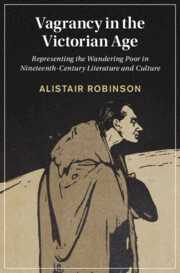Vagrancy in the Victorian Age
Representing the Wandering Poor in Nineteenth-Century Literature and Culture
$99.99 (F)
Part of Cambridge Studies in Nineteenth-Century Literature and Culture
- Author: Alistair Robinson, Birkbeck, University of London
- Date Published: October 2021
- availability: Available
- format: Hardback
- isbn: 9781316519851
$
99.99
(F)
Hardback
Other available formats:
Paperback, eBook
Looking for an examination copy?
If you are interested in the title for your course we can consider offering an examination copy. To register your interest please contact [email protected] providing details of the course you are teaching.
-
Vagrants were everywhere in Victorian culture. They wandered through novels and newspapers, photographs, poems and periodicals, oil paintings and illustrations. They appeared in a variety of forms in a variety of places: Gypsies and hawkers tramped the country, casual paupers and loafers lingered in the city, and vagabonds and beachcombers roved the colonial frontiers. Uncovering the rich Victorian taxonomy of nineteenth-century vagrancy for the first time, this interdisciplinary study examines how assumptions about class, gender, race and environment shaped a series of distinct vagrant types. At the same time it broaches new ground by demonstrating that rural and urban conceptions of vagrancy were repurposed in colonial contexts. Representational strategies circulated globally as well as locally, and were used to articulate shifting fantasies and anxieties about mobility, poverty and homelessness. These are traced through an extensive corpus of canonical, ephemeral and popular texts as well as a variety of visual forms.
Read more- Reveals the sophisticated and multiform nature of the vagrant in the Victorian cultural imagination by closely analysing a series of distinct vagrant types
- Unearths fruitful connections between national and colonial depictions of vagrancy, highlighting that Britain's strategies of representing vagrancy circulated globally as well as locally across three topographies: the country, the city and the frontier
- Incorporates material ranging from canonical literature, to newspaper articles, to visual art within its broad ambit, vividly demonstrating the mobility of vagrant figures between interconnected artistic forms
Reviews & endorsements
‘… the first notable scholarly work to concentrate exclusively upon nineteenth-century representations of vagrancy - and as such is a highly welcome addition to the wider domain of vagrancy studies, which has so far generally failed to cover this area in detail … as well as offering a wide-ranging and clear account of some of the defining transitions in nineteenth-century attitudes towards vagrancy, alongside a nuanced analysis of how different authors responded to the figure of the vagrant, Vagrancy in the Victorian Age convincingly captures a sense of how attitudes towards vagrancy converged around adjacent prejudicial and subjugatory discourses, while simultaneously providing an opportunity for radical counter-trends to flourish.’ Luke Lewin Davies, Journal of Victorian Culture Online
See more reviews‘… combines small details and considerable analysis to build a taxonomy that is structurally holistic and, often, really quite moving.’ Delphine Gatehouse, BAVS Newsletter
‘a first-rate account of the causes of poverty in the nineteenth century, the reasons for the rapid growth of London street life during this time, the blundering attempts to alleviate the misfortunes of the ‘worthy’ poor and the misguided urge to punish and reject those who were deemed unworthy.' Ana Alicia Garza, Times Literary Supplement
‘… excellent … Robinson's book has set a very high benchmark for those that will undoubtedly follow in its wake.’ Luke Seaber, Victorian Periodicals Review
‘The meticulous research and nuanced discussion of vagrancy offered in Robinson’s book thus adds to our understanding of Dickens’s representations, while stimulating us to consider their significance further.’ Tamara S. Wagner, Dickens Quarterly
‘… this book significantly adds to our understanding not only of nineteenth-century representations of poor people on the move but also of the mobilizations of those representations themselves.’ Carolyn Betensky, Modern Language Quarterly
'… a well-written and thought-provoking work, and one that in showing the protean and portable nature of the represented vagrant widens the subject in interesting ways …' Stephen Ridgwell, Journal of Victorian Culture
‘… a first-rate account of the causes of poverty in the nineteenth century, the reasons for the rapid growth of London street life during this time, the blundering attempts to alleviate the misfortunes of the 'worthy' poor and the misguided urge to punish and reject those who were deemed unworthy … groundbreaking …’ Ana Alicia Garza, The Times Literary Supplement
Customer reviews
Not yet reviewed
Be the first to review
Review was not posted due to profanity
×Product details
- Date Published: October 2021
- format: Hardback
- isbn: 9781316519851
- length: 228 pages
- dimensions: 235 x 158 x 20 mm
- weight: 0.55kg
- availability: Available
Table of Contents
Introduction
Part I. The Country
1. Gypsies, Hawkers and Handicraft Tramps
2. Poachers
Part II. The City
3. Casual Paupers
4. Loafers
Part III. The Frontier
5. Paupers, Vagabonds and American Indians
6. Beachcombers
Afterword: London 1902.
Sorry, this resource is locked
Please register or sign in to request access. If you are having problems accessing these resources please email [email protected]
Register Sign in» Proceed
You are now leaving the Cambridge University Press website. Your eBook purchase and download will be completed by our partner www.ebooks.com. Please see the permission section of the www.ebooks.com catalogue page for details of the print & copy limits on our eBooks.
Continue ×Are you sure you want to delete your account?
This cannot be undone.
Thank you for your feedback which will help us improve our service.
If you requested a response, we will make sure to get back to you shortly.
×


